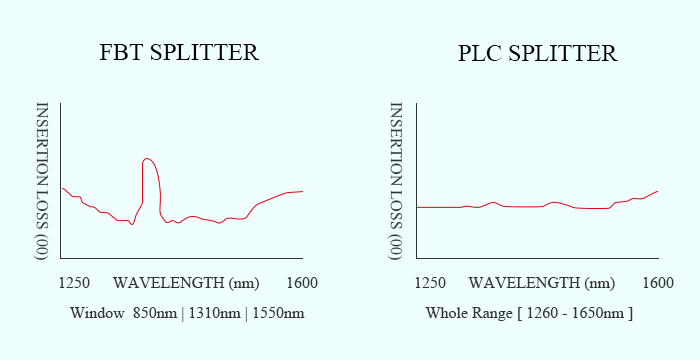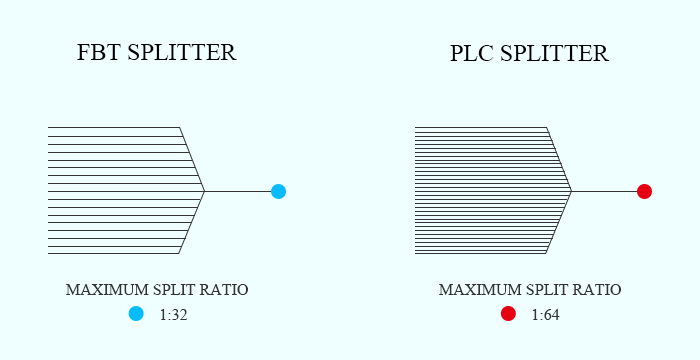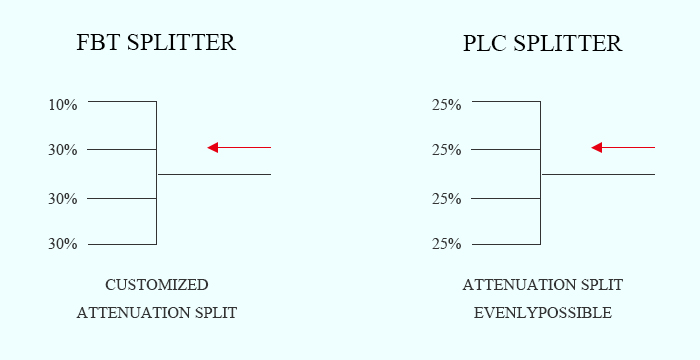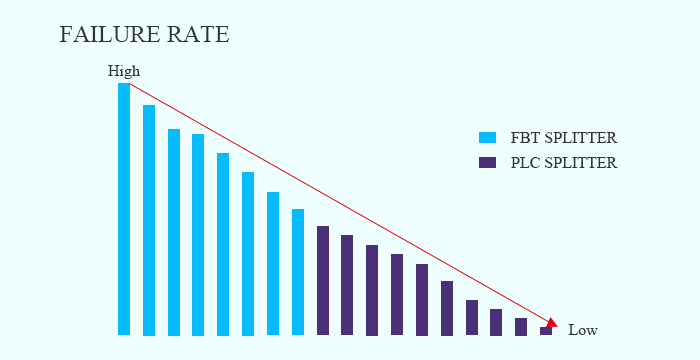PLC Splitter and FBT splitter are the two basic categories for fiber optic splitters. What is their difference when talking PLC Fiber Optic Splitter vs FBT Fiber Splitter? Fiber optic splitters play an increasingly significant role in many of today’s optical network topologies. They provide capabilities that help users maximize the functionality of optical network circuits from FTTx systems to traditional optical networks. And usually they are placed in the central office or in one of the distribution points (outdoor or indoor). Let’s talk about PLC Fiber Optic Splitter vs FBT Fiber Splitter
(1) Operating Wavelength
FBT splitter can only support three wavelengths: 850nm, 1310nm and 1550nm, which makes its inability to works on other wavelengths. While PLC splitter can support wavelength from 1260 to 1650nm. The adjustable rang of wavelength makes PLC splitter suitable for more applications.

(2) Splitting Ratio
Splitting ratio is decided by the inputs and outputs of an optical cable splitter. The maximum split ratio of FBT splitter is up to 1:32, which means one or two inputs can be splitted into an output maximum of 32 fibers at a time. However, the split ratio of PLC splitter is up to 1:64 – one or two inputs with an output maximum of 64 fibers. Besides, FBT splitter is customisable, and the special types are 1:3, 1:7, 1:11, etc. But PLC splitter is non-customisable, and it has only standard version like 1:2, 1:4, 1:8, 1:16, 1:32 and so on.

(3) Assymetric Attenuation Per Branch
The signal processed by FBT splitters cannot be splitted evenly due to lack of management of the signals, so its transmission distance can be affected. However, PLC splitter can support equal splitter ratios for all branches, so it is more stable.

(4) Failure Rate
FBT splitter is typically used for networks requiring the splitter configuration of less than 4 splits. The larger the split, the larger failure rate. When its splitting ratio is larger than 1:8, more errors will occur and cause higher failure rate. Thus, FBT splitter is more restricted to the number of splits in one coupling. But the failure rate of PLC splitter is much smaller.

(5) Temperature Dependent Loss
In certain areas, temperature can be a crucial factor that affects the insertion loss of optical components. FBT splitter can work stable under the temperature of -5 to 75℃. PLC splitter can work at a wider temperature range of -40 to 85 ℃, providing relatively good performance in the areas of extreme climate.
(6) Price
Owing to the complicated manufacturing technology of PLC splitter, its cost is generally higher than the FBT splitter. If your application is simple and short of funds, FBT splitter is definitely a cost-effective solution.
For more details about the difference, You can take a look at the below datasheet to compare.
| Parameters | FBT Splitter | PLC Splitter |
| Fabrication Method | Two or more pieces of optical fibers are bound together and put on a fused-taper fiber device. The fibers are then drawn out according to the output branch and ratio with one fiber being singled out as the input. | Consists of one optical chip and several optical arrays depending on the output ratio. The optical arrays are coupled on both ends of the chip. |
| Splitting Ratio | Uneven | Even |
| Operating Wavelength | 1310nm or 1490nm or 1550nm | 1260nm -1650nm (full wavelength) |
| Application | HFC (network of fiber and coaxial cable for CATV); All FTIH applications. | Same |
| Performance | Up to 1:8 – reliable. For larger splits reliability can become an issue. | Good for all splits. High level of reliability and stability. |
| Input/Output | One or two inputs with an output maximum of 32 fibers. | One or two inputs with an output maximum of 64 fibers. |
| Package | Steel Tube (used mainly in equipment); ABS Black Module (Conventional) | Same |
| Input/Output Cable | Bare optical fiber; 0.9mm, 2.0mm and 3.0mm | Same |
| Part Number Example | FOSPLT-T-FBT-1/2-E-SM-SC/APC | FOSPLT-T-PLC-1/2-E-SM-SC/APC |
Conclusion
Although the outer appearance and size of FBT and PLC fiber splitter seem rather similar, their internal technologies and specifications differ in various ways. Over the past few years, splitter technology has made a huge step forward in the past few years by introducing PLC splitter. It has proven itself as a higher reliable type of device compared to the traditional FBT splitter.

.png)